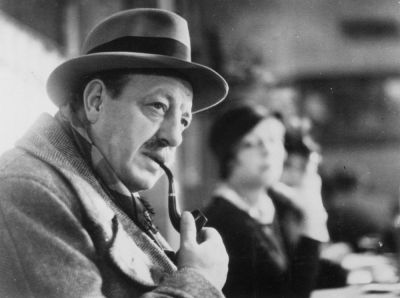
LA TÊTE D’UN HOMME
(Il delitto della villa, Francia/1933) R.: Julien Duvivier. D.: 98'. V. francese
Georges Simenon era rimasto deluso dai primi film ispirati ai suoi romanzi, La Nuit du carrefour (1932) di Jean Renoir (oggi considerato un capolavoro) e Le Chien jaune (1932) di Jean Tarride. Decise quindi di scrivere egli stesso l'adattamento e addirittura dirigere la versione filmica di La Tête d'un homme (pubblicato nel 1931). Scelse come interpreti Pierre Renoir (già Maigret di Renoir) e Valéry Inkijinoff, attore russo da poco emigrato in Francia. Ma dopo un intoppo finanziario, Simenon si allontanò dal progetto e i produttori lo proposero a Julien Duvivier che mantenne Inkijinoff per il ruolo di Radek e impose per la parte del commissario Harry Baur, che aveva già diretto in David Golder (1931), Les Cinq gentleman maudits (I cavalieri della morte, 1931) e Poil de carotte (Pel di carota, 1932). Seguendo lo snodarsi di un'indagine poliziesca, il romanzo racconta il duello fra due figure antitetiche: il diabolico Radek, studente immigrato ceco, esecutore di un 'delitto perfetto' per conto terzi, che, malato incurabile, vuole sfidare la legge, e Maigret. La misantropia e il cinismo di Radek costituivano una materia ideale per l'ispirazione noir di Duvivier che modificò drasticamente la struttura della storia e ne privilegiò la psicologia e l'atmosfera con una voluta accentuazione degli echi dostoevskiani. "Il punto di partenza di questo romanzo m'inquietava. Nel libro di Simenon si tratta di un poliziotto che fa evadere un condannato a morte. [...] In un romanzo, evidentemente, si possono far accadere delle cose talvolta inverosimili, ma noi ci troviamo, al cinema, nella necessità di obbedire ad alcune convenzioni e mi sembrava pericoloso imbastire un intero dramma su una base così facilmente discutibile. Ho quindi sottoposto il fatto alle autorità giudiziarie e mi hanno dimostrato che una cosa simile era francamente impossibile. Per metterla in pratica, sarebbe necessario comprare il silenzio di una trentina di funzionari che d'altronde sono, si sa, assolutamente incorruttibili" ("Cinémonde", n. 225, 9 febbraio 1933). Dopo aver rivelato subito al pubblico quali fossero i colpevoli (mandante e sicario), Duvivier si concentrò sul gioco dialettico fra Radek e Maigret, sulle loro diverse disillusioni che si confrontano in un clima opprimente e corrotto, dove ricorrono inquadrature claustrofobiche e talvolta espressionistiche, spesso in dettaglio sui volti e gli sguardi dei personaggi. Di particolare originalità l'uso del sonoro, soprattutto nella sequenza in cui il falso colpevole viene torchiato durante un tragitto in automobile e non si vedono mai i personaggi che parlano ma il paesaggio che scorre intorno a loro. Le parole della canzone Complainte sono dello stesso Duvivier.
(Roberto Chiesi)
Georges Simenon was disappointed by the first films based on his novels, La Nuit du carrefour (1932) by Jean Renoir (now considered a masterpiece) and Le Chien jaune (1932) by Jean Tarride. As a result, he decided to write the adaptation for and even direct himself the film version of La Tête d'un homme (published in 1931). As actors, he chose Pierre Renoir (who had played Renoir's Maigret) and Valéry Inkijinoff, a Russian actor recently emigrated to France. After a financial mishap, Simenon backed away from the project, and the producers proposed it to Julien Duvivier who tapped Inkijinoff for the role of Radek. For the role of the detective he insisted on Harry Baur, whom he had already directed in David Golder (1931), Les Cinq gentleman maudits (1931) and Poil de carotte (1932). Chronicling a police investigation, the novel depicts a duel between two opposing characters: the diabolical Radek, a Czech immigrant student, mastermind of the 'perfect murder' for a third party, who has an incurable disease and wants to subvert the law, and Maigret. Radek's misanthropy and cynicism provided the ideal raw material for Duvivier's noir inspiration. He drastically modified the story's structure to focus on its psychological elements and mood, intentionally emphasizing Dostoevskian references. "The starting point of this novel worried me. In Simeon's book, a policeman allows a death row inmate to escape. [...] Obviously in a novel the author can create implausible situations, but in film the director is bound by some norms and conventions. I thought it would be risky to base an entire drama on such a debatable basis. So I posed the scenario to the authorities, who demonstrated to me how such a plan would be, frankly, impossible to carry out. In order to work, it would require that the perpetrator corrupt around thirty officials who are, as is widely known, completely incorruptible". ("Cinémonde", n. 225, February 9, 1933). Duvivier chose to reveal to the public both the killer and the person who ordered the hit in the beginning, shifting the dramatic focus to the verbal jousting between Radek and Maigret and to their respective disenchantments that square off in an oppressive and corrupt environment. This climate is exacerbated by the claustrophobic and occasional expressionist camera takes, often close-ups of the faces and expressions of characters. The use of sound is particularly original, especially in the sequence when the falsely accused man is grilled during a car ride and the audience never sees the characters who are speaking, but only the scenery unfolding around them. The words of the song Complainte were written by Duvivier himself.
(Roberto Chiesi)

Tariffe:
Aria condizionata
Accesso disabili
Tel. 051 522285











